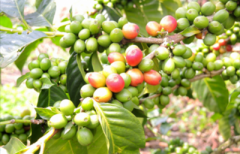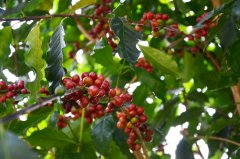Visit the Colombian coffee belt to learn how to taste Colombian coffee.
For professional baristas, please follow the coffee workshop (Wechat official account cafe_style)
Colombia's most famous crop, apart from drugs, should be coffee beans. The country's coffee output is the 3rd / 4th largest in the world-Brazil, the largest producer, followed by Vietnam (a little unexpected, but Vietnam mainly produces Robusta, whose quality and price are far lower than the main Arabica beans, so people's chances of drinking Vietnamese coffee are not high). The output of Colombia and Indonesia is very similar. The ranking depends on whether the two countries have a bumper harvest or a bad harvest.
Coffee beans are produced in many places in Colombia, but the central "coffee belt" is the most famous, and it is the second most popular tourist spot in the country after Cartagena. In addition to coffee beans, there is also more than a century of local coffee farm culture, which has been listed as a United Nations World Heritage site.
The so-called "coffee belt" is located about seven hours west of the capital Bogota and seven hours south of Medellin. It includes three provinces, Caldas, Risaralda and Quindio, with their capitals Manizales, Pereira and Armenida. Locals are used to calling it the "coffee axis" (Eje Cafetero), but when the government promoted tourism a few years ago, it happened that the United States was in full swing in the fight against terrorism. The "axis" became Axis in English, reminiscent of the "axis of evil" that the US government was talking about every day, so the English promotional material was changed to the "coffee golden triangle"-but in Chinese. The "Golden Triangle" is reminiscent of drugs that the Colombian government doesn't want the outside world to think of.
There are about 24000 coffee farms in this area, mainly small farms, but there are also large plantations, many of which are for tourists and even provide hotel accommodation services at the same time. There are coffee trees everywhere, and even by car, the scenery of Manshan coffee trees can be seen everywhere on the road.
I went to a larger and smaller coffee farm, the Hacienda Venecia near Manizales, which has about 70 to 80 full-time employees on weekdays, and as many as 500 people worked on the estate during the coffee harvest season. The smaller coffee garden, Plantation House, is in Salento, a small town near Armenia, which was bought by an Englishman a few years ago.
The two coffee garden delegations introduced the process of growing coffee trees, such as how long it takes for coffee beans to be harvested, or how long it takes for a coffee tree to be discarded for about 20 years, so that it can no longer produce marketable coffee beans. They will also talk about how to peel off the red skin to remove coffee beans, and then gradually dry the coffee beans with a layer of gel and white on the outside into dark brown coffee beans that we usually see.
The most interesting thing about these tours is how to taste coffee-not a cup of brewed coffee, but coffee beans. At Hacienda Venecia, the commentator first asked us to sniff two groups of dried coffee beans, one of which is of better quality and will be sold to the market, while the other is of poor quality and will not be sold to the market. Then he uses a machine to grind the coffee beans into powder, then heat the water to make the coffee, and then remove the top layer of foam from the coffee. Before we officially taste two cups of coffee, we sniff at each step to see if we can smell the difference. Finally, it is estimated that the more bitter cup is made of poor quality coffee beans.
If time permits, you can choose which coffee farms to stay, for example, the following is Hacienda Venecia--, although I don't stay there! ):
However, be psychologically prepared. These farms are far from the city center, about an hour's drive, and there is no public transport connection. Once they have entered the accommodation, they can only look at the hillsides covered with mountain coffee trees, and do not rule out the fact that they are not connected to the Internet. It's best to take a book to write a letter or write a diary.
The cultural landscape of the coffee belt is slightly different from the impression that the houses in South American towns are colorful. Many Latin American cities were founded in the 16th century (Columbus "discovered the New World" in 1492). The coffee belt developed relatively late and did not develop until the mid-18th century when people in the northern province of Antioquia began to move in. The most special local architectural feature is that the house follows the technology of local indigenous residents to build houses with bamboo, mainly because there is a lot of bamboo in the area.
Of course, there are colorful cities and towns, such as Salento. It takes less than an hour to walk around the town center, but the houses in the town are painted with colorful colors to piece together a beautiful street view (my photos are poor, you can Google search "Salento").
Important Notice :
前街咖啡 FrontStreet Coffee has moved to new addredd:
FrontStreet Coffee Address: 315,Donghua East Road,GuangZhou
Tel:020 38364473
- Prev

Coffee beans that are easy to brew successfully-Colombian Coffee beans Colombian San Tuareo Manor
For professional baristas, please pay attention to the coffee workshop (Wechat official account cafe_style) Colombian coffee is widely sold in many producing countries, ranking the third largest in the world (the first is Brazilian coffee and the second is Vietnamese coffee). The main factor is that the active volcanic activity has created the most fertile soil in the world, which is sweet, rich, very pleasing and easy to brew.
- Next

How does Fapa Camara taste after dry sun treatment? orange Fruit Manor selection Coffee Bean selection process
For the exchange of professional baristas, please follow the coffee workshop (Wechat official account cafe_style) El Naranjo Dipilto. Orange Fruit Manor (Best of Nicaragua winning Manor | Award record: 2016. 1st place) non-water sun treatment Nicaraguan Coffee Variety: Pacamara/ Pacamara Manor owner: Luis Emilio Valladarez Zelaya producing area: Nu
Related
- Detailed explanation of Jadeite planting Land in Panamanian Jadeite Manor introduction to the grading system of Jadeite competitive bidding, Red bid, Green bid and Rose Summer
- Story of Coffee planting in Brenka region of Costa Rica Stonehenge Manor anaerobic heavy honey treatment of flavor mouth
- What's on the barrel of Blue Mountain Coffee beans?
- Can American coffee also pull flowers? How to use hot American style to pull out a good-looking pattern?
- Can you make a cold extract with coffee beans? What is the right proportion for cold-extracted coffee formula?
- Indonesian PWN Gold Mandrine Coffee Origin Features Flavor How to Chong? Mandolin coffee is American.
- A brief introduction to the flavor characteristics of Brazilian yellow bourbon coffee beans
- What is the effect of different water quality on the flavor of cold-extracted coffee? What kind of water is best for brewing coffee?
- Why do you think of Rose Summer whenever you mention Panamanian coffee?
- Introduction to the characteristics of authentic blue mountain coffee bean producing areas? What is the CIB Coffee Authority in Jamaica?

